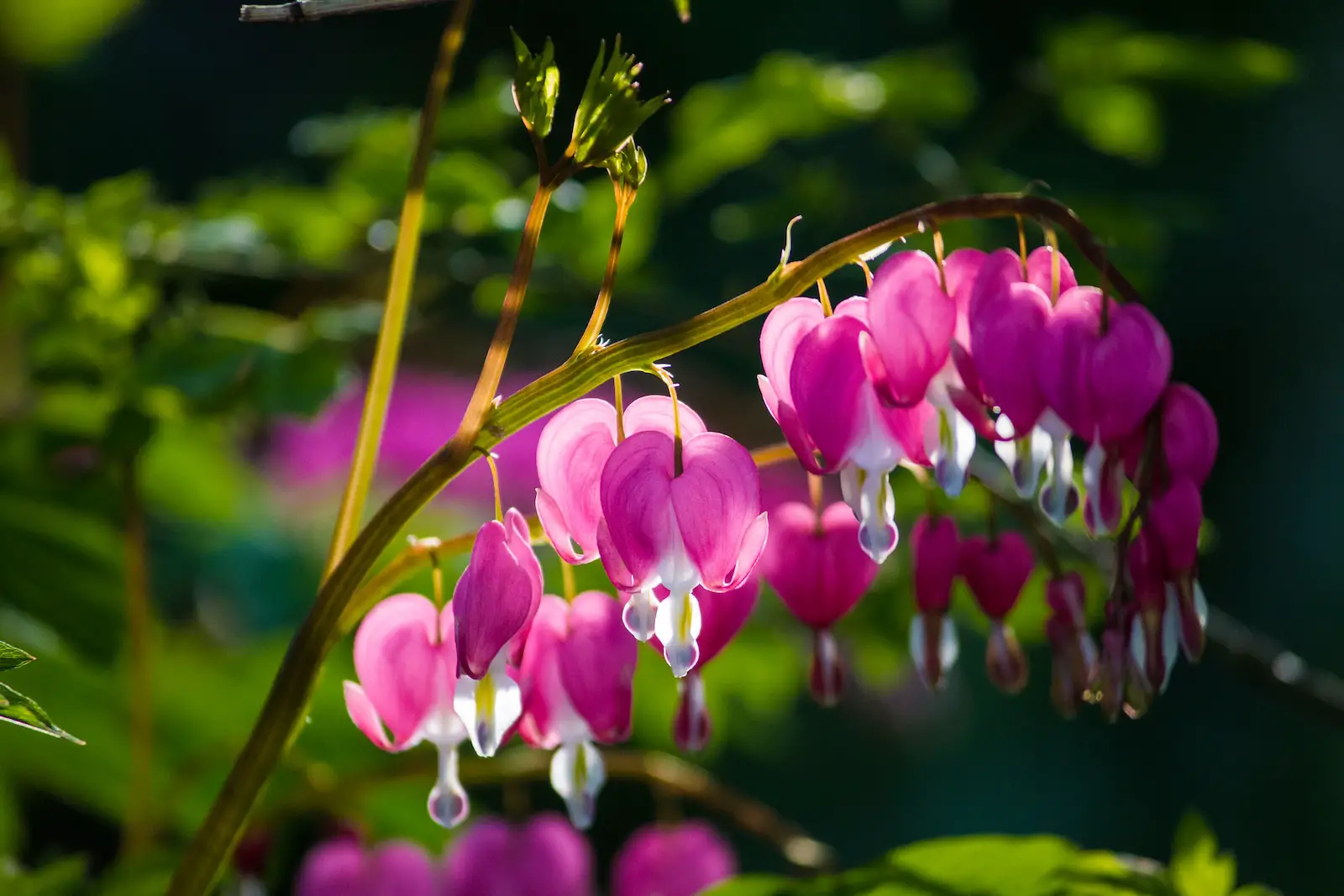Bleeding Hearts are among the most graceful and eye-catching perennials with their unique heart-shaped flowers that seem to “bleed” at the bottom. Their botanical name, Dicentra spectabilis, comes from Greek and Latin words that describe the unusual appearance of the blossoms.
Native to Asia, Bleeding Hearts have been cultivated in gardens for centuries, admired for their delicate appearance and vibrant pink and white color. In addition to their stunning looks, these plants are rich in symbolism, often associated with romance, passion, and unrequited love.
Although Bleeding Hearts look delicate, they are relatively hardy and can thrive in various climates, provided they receive proper care. Their ephemeral beauty makes them a favorite choice for shaded gardens, where they bloom in late spring to early summer, providing a unique visual appeal.
| Attribute | Details |
|---|---|
| Common Names | Bleeding Hearts, Dutchman’s Breeches, Lyre Flower |
| Botanical Name | Dicentra spectabilis |
| Family | Papaveraceae |
| Plant Type | Perennial |
| Mature Size | 1-3 feet tall, 1-2 feet wide |
| Sun Exposure | Partial Shade |
| Soil Type | Moist, well-drained, organic soil |
| Hardiness Zones | 3-9 |
| Native Area | Asia |
Bleeding Hearts Care
Caring for Bleeding Hearts is a fairly straightforward process. These plants are best grown in partial shade, sheltered from strong winds, with rich, moist soil. Although adaptable to different conditions, they are most vibrant when provided with the proper combination of sunlight, water, and nutrients.
Mulching around the base of Bleeding Hearts can help retain soil moisture and keep the roots cool. Being attentive to their needs during the growing season, cutting back the foliage after it turns yellow in the fall, and avoiding over-watering or heavy clay soil can lead to healthy growth and beautiful blooms.
Light Requirement for Bleeding Hearts
Bleeding Hearts perform best in partial shade, receiving some sunlight but protected from harsh afternoon sun. They appreciate bright but indirect light that promotes growth without scorching the delicate foliage and blooms.
Soil Requirements for Bleeding Hearts
A moist, well-drained, and organic-rich soil provides the ideal growing conditions for Bleeding Hearts. A soil pH of 6.0 to 7.0 is optimal, and adding compost or well-rotted manure can enhance fertility.
Water Requirements for Bleeding Hearts
Consistent moisture is crucial for Bleeding Hearts, especially during the blooming season. They prefer evenly moist soil, but not soggy or waterlogged conditions. Regular watering without over-saturating the ground is key to their healthy development.
Temperature and Humidity
Bleeding Hearts are hardy in USDA zones 3-9, tolerating cold winters. They appreciate a moderate humidity level, neither too dry nor too damp, as extreme humidity conditions can lead to fungal problems.
Fertilizer
A balanced, slow-release fertilizer applied in early spring supports the growth of Bleeding Hearts. They benefit from nutrients but are not heavy feeders, so avoid over-fertilizing, which could cause leggy growth.
Pruning Bleeding Hearts
Pruning Bleeding Hearts mainly involves removing dead or yellowing foliage in late fall. Cutting back the foliage after it turns yellow allows the plant to conserve energy for the following season.
Propagating Bleeding Hearts
Propagation can be done through division in late fall or early spring. Carefully dividing the clump with a sharp spade, ensuring that each division has some roots and shoots, will create new plants.
How To Grow Bleeding Hearts From Seed
Growing Bleeding Hearts from seed is a slow process. Seeds need to be stratified in a refrigerator for several weeks before sowing in well-prepared soil. It may take up to a year or more to see flowering.
Common Pests & Plant Diseases
Aphids
Aphids can be managed with insecticidal soap or neem oil.
Downy Mildew
This fungal disease can be avoided by providing proper air circulation and avoiding overhead watering.
Common Problems With Bleeding Hearts
Yellowing Leaves
Over-watering or poor drainage can cause yellowing leaves. Ensure that the soil is well-drained and avoid over-watering.
Lack of Blooms
Improper sunlight or nutrient imbalance may lead to a lack of blooms. Adjusting the sunlight exposure and soil nutrients can often resolve this issue.
Pro Tips
- Plant in a sheltered location with partial shade for best results.
- Maintain consistent moisture without over-watering.
- Cut back foliage in the fall to conserve energy.
- Divide mature plants every few years to maintain vigor.
- Pair with other shade-loving perennials for an attractive garden display.



